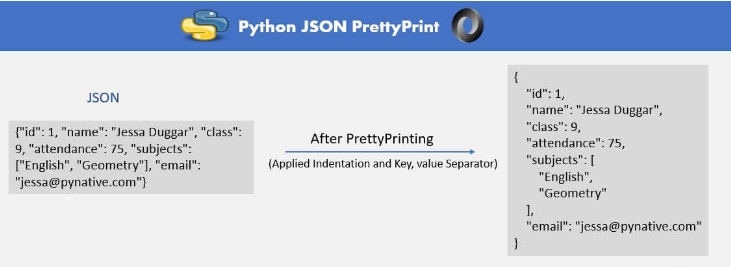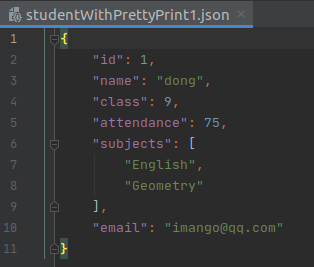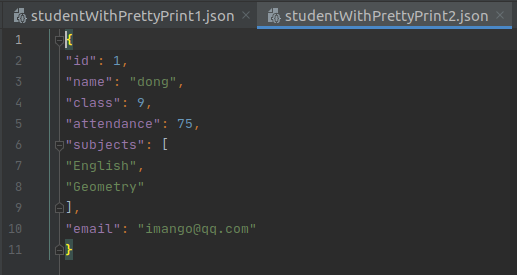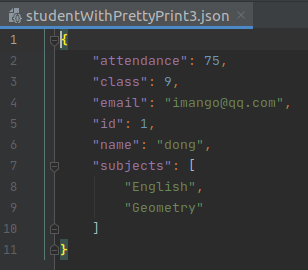- JSON和Python
- JSON和Python(1)
- python中的Json(1)
- Python JSON(1)
- Python JSON(1)
- JSON 与Python
- Python JSON
- Python JSON
- JSON 与Python(1)
- JSON(1)
- JSON
- json (1)
- json python 代码示例
- python代码示例中的Json
- javascript中的json(1)
- JavaScript JSON(1)
- JavaScript JSON
- json javascript (1)
- JavaScript和JSON
- JavaScript JSON(1)
- JavaScript JSON
- JavaScript和JSON(1)
- json - Javascript (1)
- {{我 | json}} - Javascript (1)
- 数据格式 pandas - Python 代码示例
- html转json python(1)
- Excel 中的数据格式
- Excel 中的数据格式(1)
- 示例 json - Javascript (1)
📅 最后修改于: 2020-08-29 02:23:16 🧑 作者: Mango
在之前章节中,我们学习了如何保存Json数据到文件。
然后,在保存后的文件虽然是json文件,但是数据格式杂乱,很不易于阅读。在这种情况下,就需要我们json数据格式更易于阅读。因此,我们这节介绍PrettyPrinted方法。
在Python中需要JSON PrettyPrinting的场景:
- 将PrettyPrinted JSON格式的数据写入文件
- Prettyprint JSON文件:假设您有一个巨大且未正确缩进的JSON文件,并且您想对其进行漂亮打印。
- Prettyprint JSON格式的字符串。
下图简单介绍方法的效果:

将PrettyPrinting的JSON数据写入文件
在实际情况下,我们处理大量的JSON数据。当我们将JSON数据写入文件时,我们必须确保JSON数据可读且组织良好,因此无论使用哪种格式的数据,都可以更好地理解JSON的结构。
使用json.dumps()方法,我们可以将prettyprinted JSON写入文件中。该方法提供以下参数来格式化的写入JSON数据。
indent参数指定在一行的开头使用的空间。我们可以使用json.dump()的indent参数来指定缩进值。默认情况下,当您将JSON数据写入文件时,Python不会使用缩进,而是将所有数据写入一行,这是不可读的。
separator参数:可以指定JSON键和值之间的任何分隔符。默认分隔符为(', ', ': ')。例如,如果指定分隔符(例如)(', ', ' : '),则JSON将看起来像这样。
sort_keys用于按字母顺序对JSON键进行排序的 参数。
import json
print("Writing Indented and Pretty-printed JSON formatted data into a file")
student = {
"id": 1,
"name": "dong",
"class": 9,
"attendance": 75,
"subjects": ["English", "Geometry"],
"email": "imango@qq.com"
}
with open("studentWithoutPrettyPrint.json", "w") as write_file:
json.dump(student, write_file)
print("Done writing JSON data into file without Pretty Printing it")
with open("studentWithPrettyPrint1.json", "w") as write_file:
json.dump(student, write_file, indent=4)
print("Done writing PrettyPrinted JSON data into file with indent=4")
with open("studentWithPrettyPrint2.json", "w") as write_file:
json.dump(student, write_file, indent=0)
print("Done writing PrettyPrinted JSON data into file with indent=0")
with open("studentWithPrettyPrint3.json", "w") as write_file:
json.dump(student, write_file, indent=4, sort_keys=True)
print("Done writing Sorted and PrettyPrinted JSON data into file")我们看看第一个,直接保存后的文件:

我们看看第二个,indent=4保存后的文件:

我们看看第三个,indent=0保存后的文件:

我们看看第三个,排序后保存后的文件:

记得:
如果indent是非负整数或字符串,则JSON数组元素和对象成员将使用该缩进级别进行漂亮打印。例如,当我们指定indent = 4时,Python使用四个空格进行缩进。
缩进级别为0,为负或””仅插入换行符。无(默认)选择最紧凑的表示形式。使用正整数缩进会使每个级别缩进多个空格。如果indent是字符串(例如\t),则该字符串用于缩进每个级别。
调整从文件load的JSON数据
假设您有一个不正确缩进的JSON文件,并且想要对其格式调整。
我们需要执行以下步骤:
- 首先使用json.load()方法读取JSON文件。
- 通过指定缩进和分隔符,可使用json.dumps()方法正确打印JSON。该json.dumps()方法以字符串格式返回prettyprinted JSON数据。
打印最终的JSON。
import json
with open("./student.json", "r") as read_file:
print("Read JSON file")
student = json.load(read_file)
print("Before Pretty Printing JSON Data")
print(student)
print("\n")
PrettyJson = json.dumps(student, indent=4, separators=(',', ': '), sort_keys=True)
print("Displaying Pretty Printed JSON Data")
print(PrettyJson)结果如下:
Read JSON file
Before Pretty Printing JSON Data
{'id':1,'name':'Jessa Duggar','class':9,'出席':75,'subjects':['English','Geometry','Physics','World History'] ,“电子邮件":“ jess@example.com"}
Displaying Pretty Printed JSON Data
{
“出勤":75,
“类别":9
“ email":“ jess@example.com",
“ id":1
“ name":“ Jessa Duggar",
“主题":[
“英语",
“几何",
“物理",
“世界史"
]
}使用pprint模块格式化打印JSON
该pprint模块提供了“漂亮打印”任何Python数据结构的功能。现在,让我们看看如何使用该pprint模块漂亮地打印JSON数据。
该pprint.pprint()函数在已配置的流上打印JSON的格式化表示形式,后跟换行符
- 首先通过配置缩进和宽度值构造一个PrettyPrinter实例。另外,设置
compact=False。 - 使用
json.load()方法读取JSON文件。 - 将JSON数据传递给
pprint.pprint()函数
import json
import pprint
with open("studentWithoutPrettyPrint.json", "r") as read_file:
print("Read JSON file")
student = json.load(read_file)
print("Before Pretty Printing JSON Data")
print(student)
print("\n")
# construct PrettyPrinter first
pp = pprint.PrettyPrinter(indent=4, width=80, compact=False)
print("Pretty Printing JSON Data using pprint module")
pp.pprint(student)结果显示如下:
Read JSON file
Before Pretty Printing JSON Data
{'id': 1, 'name': 'dong', 'class': 9, 'attendance': 75, 'subjects': ['English', 'Geometry'], 'email': 'imango@qq.com'}
Pretty Printing JSON Data using pprint module
{ 'attendance': 75,
'class': 9,
'email': 'imango@qq.com',
'id': 1,
'name': 'dong',
'subjects': ['English', 'Geometry']}
注意:仅使用打印在控制台上显示JSON数据。切勿使用其输出将JSON写入文件。
使用命令行如何格式化打印Json数据
有些时候我们不得不命令行来打印出Json数据。
Python提供了json.tool模块,用于从命令行验证和漂亮地打印JSON对象。我们可以使用其模块的命令行界面执行以下任务。
命令如下:
python -m json.tool filePath
演示结果输出:
{
"id": 1,
"name": "dong",
"class": 9,
"attendance": 75,
"subjects": [
"English",
"Geometry"
],
"email": "imango@qq.com"
}
与此同时,也可以格式化的讲Jsons数据重定向到新的文件;
python -m json.tool oriFileName newFile.json
——–>>>>>